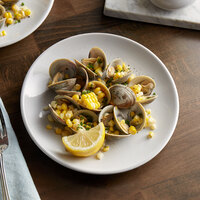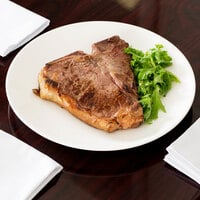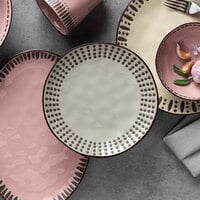
The majority of dinnerware items fall into the following categories:
Earthenware
Often less expensive than other types of dinnerware, earthenware is ceramic that has been glazed and fired. It has a thick, heavy, and rustic look and feel, but is not as durable and strong as other types of dinnerware and is prone to chipping. Dishware with hand-painted designs are typically earthenware.
Earthenware is often porous, which means it could stain or absorb liquid, so you do need to avoid leaving it submerged in water. Most glazed earthenware is dishwasher safe and can be used in the microwave, but it is wise to check with the manufacturer first.
Stoneware
Another type of fired ceramic dinnerware, stoneware is a little more durable than earthenware because the clay is fired at a higher temperature and usually has vitreous (glass) material added to it for strength. The body of stoneware is thicker and more opaque than finer materials like porcelain and China and can be finished with a variety of glaze textures such as shiny, satin, or matte.
Stoneware is typically used in casual, everyday place settings. Most good-quality stoneware is very versatile to use and easy to maintain. It can go in the microwave, dishwasher, oven, and freezer, but always check with the manufacturer for the specific qualities of your dinnerware. It should not, however, be exposed to sudden or extreme temperature changes. Ironstone is a type of stoneware and brands to look for include Pfaltzgraff, Dansk (Lenox) and Fiesta (Homer Laughlin).
Porcelain or China
Porcelain and China are both terms that refer to dinnerware made of a fine-particle clay—typically comprised of feldspar, kaolin, and quartz—that is fired at a higher temperature. This makes the resulting dinnerware extremely durable and nonporous. This process also allows the body to be thinner and more delicately constructed which gives it an almost translucent appearance, as well as allowing for shaped details to be incorporated into the design of the body.
Most fine china is dishwasher, microwave, and oven-safe unless the manufacturer indicates otherwise. China that has a gold, silver, or platinum border should not be microwaved and lemon or citrus-scented detergent could damage metal accents. Many people hand-wash their metal-accented porcelain dishes.
Porcelain often has an upscale look, lending itself to more formal dining occasions, but it also can be used every day to make any meal a little more elegant. Brands to look for include Lenox, Noritake, and Villeroy & Boch.
Bone China
Bone ash (which is made from animal bones) is combined with porcelain clay and fired at a slightly lower temperature than porcelain to produce a material that is very lightweight, delicate in feel, and translucent with a milky appearance.
Despite its fragile presentation, bone china is actually the strongest and most durable ceramic dinnerware. Most bone china is dishwasher-safe and, unless it has metallic banding, can go in the microwave and oven as well. Bone china, as with porcelain, can be used daily or reserved for a more formal dining occasion. Brands to look for include Royal Doulton, Wedgewood, and Mikasa.
Melamine
If you’re looking for unbreakable plates, Melamine is the way to go. This plastic material is lightweight but has a sturdy, inflexible feel and a glossy finish. It is virtually indestructible and is ideal for children and outdoor use. It is usually dishwasher safe on the top rack, but not suitable for the microwave or oven and should not be heated with food in it. Melamine is BPA-free. Zak! Designs is a good brand for Melamine dinnerware.
Vitrified Glass
Vitrified glass is glass, usually opaque in the case of dinnerware, that has been fired at an ultra-high temperature so that it is nonporous and extremely durable. The best-known vitrified glass dinnerware is Corelle, which is a proprietary glass laminate that is virtually indestructible—it will not break or chip even when dropped onto a hard floor. Vitrified glass is safe to use in the dishwasher and microwave.
Porcelain
- Made of malleable clay for forming detailed shapes
- Durable, vitrified construction
- More affordable compared to traditional and bone china
- Most pieces are dishwasher, microwave, and oven safe

China
- Made of malleable clay for forming detailed shapes
- Durable, vitrified construction
- Perfect for casual to fine dining and is available in a variety of colors, shapes, and designs
- Most pieces are dishwasher, microwave, and oven safe

Bone China
- Contains at least 25% bone ash; most expensive chinaware
- Vitrified and glazed construction protects from chipping and scratching
- Thin-walled for a delicate, refined look makes it perfect for upscale establishments
- Most pieces are dishwasher, microwave, and oven safe

Stoneware
- Fully or semi vitrified to make it hard, dense, and durable
- Great for Asian restaurants, upscale bistros, or catering companies
- Microwave and dishwasher safe

Earthenware
- Glazed to a non-vitreous state
- Lightweight, yet durable with excellent heat construction
- Least expensive type of dinnerware; will add a rustic feel to your table setting
- Hand wash only
Differences Between Porcelain and China
Porcelain and fine china have some key differences to set them apart from each other. China becomes vitrified through a single-firing process, while porcelain becomes vitrified through a two-firing process. Porcelain has a hard finish, but is brittle compared to china, which also makes it the more affordable option. China is also available in a variety of colors, shapes, and designs.
Differences Between China and Bone China
China and bone china have some key differences to set them apart from each other. China is made from a malleable clay, while bone china is made of clay that contains at least 25% bone ash and will typically be the most expensive chinaware. Bone china features glazes that protect it from chipping and scratching. Bone china also is thin-walled for a delicate, refined look, to make it lighter than china and perfect for upscale establishments.
High-fired
High-fired chinaware is a collection of ceramics that are fired in extremely high temperatures in a kiln. This temperature can be between 1,200 degrees Celsius (2,192 degrees Fahrenheit) and 1,400 degrees Celsius (2,552 degrees Fahrenheit). Hard-paste porcelain is one type of high-fired chinaware. The properties of this type of chinaware include strength, toughness and translucence.
Low-fired
Low-fired chinaware is still fired at a high temperature, but it is slightly lower than high-fired and then placed in an even lower temperature for the glazing process. Low-fired or soft-paste porcelain is fired at 1,100 to 1,200 degrees Celsius (2010 to 2192 degrees Fahrenheit) and then it is fired again at 1050 degrees Celsius (1920 degrees Fahrenheit). One type of chinaware created this way is bone china, which actually used bone ash in its original creation.
Earthenware
Earthenware is a type of chinaware that is made from refined clay plus other ingredients that give it a whiter body. This type of dinnerware resists chipping and has fewer breakages than pottery because it is less porous. Earthenware is also opaque.
Ceramics
Ceramics are chinaware made from unrefined earth materials like clay and sand. Ceramics are then processed by baking or cooking in a kiln. The clay is of lower quality than other types of chinaware and it does not become hard and glassy (vitrified) after it is fired. Ceramics are similar to earthenware but they are less durable.
Stoneware
Chinaware that is made of a single light clay and then fired at a high temperature is referred to as stoneware. This slightly gray cast is nonporous and extremely durable.
China
China is a nonabsorbent, nonporous clayware made of special white clay and cooked at an extremely high temperature. The finest china is typically thin, resistant to chipping, translucent and it will ring clearly when it is tapped.
Sources:
https://www.thespruceeats.com/dinnerware-materials-908883
https://www.webstaurantstore.com/guide/554/types-of-chinaware.html